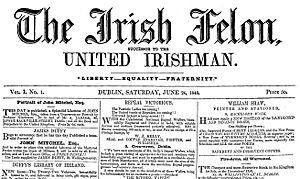The Irish Felon facts for kids
 |
|
| Type | weekly newspaper |
|---|---|
| Founded | 24 June 1848 |
| Political alignment | Irish nationalism |
| Language | English |
| Headquarters | Dublin |
The Irish Felon was a newspaper published in Dublin, Ireland, in 1848. It was a weekly journal that supported Irish independence. Only five issues were printed before the British Government stopped it.
Contents
The Story of The Irish Felon Newspaper
How It All Started
Before The Irish Felon, there was another newspaper called The United Irishman. It was started by John Mitchel in February 1848. Mitchel used to write for The Nation, a paper that supported Daniel O'Connell's Repeal Association. This group wanted to end British rule in Ireland.
However, Mitchel wanted to be more direct. He left The Nation to create his own paper, The United Irishman. This new paper encouraged people to stand up against the government. Another member of a group called Young Ireland, John Martin, also wrote for Mitchel's paper.
John Mitchel's Arrest
John Mitchel was arrested because of his writings. He was first accused of trying to cause trouble against the government. Then, he was charged with a new, very serious crime called "treason felony." This meant he was accused of trying to overthrow the government. On May 21, 1848, he was sentenced to 14 years in a faraway place called Van Diemen's Land (now Tasmania, Australia).
The Birth of The Irish Felon
After Mitchel's arrest, John Martin wanted to continue his message. Another paper, The Irish Tribune, appeared on June 10. It had a story about Mitchel. But it also announced Martin's new newspaper, The Irish Felon.
Martin said The Irish Felon would be the "successor to the United Irishman." Two other Young Ireland members, Thomas Devin Reilly and James Fintan Lalor, would help him. The new paper promised to be similar to The United Irishman. People who had subscribed to Mitchel's paper would get The Irish Felon instead. The first issue of The Irish Felon came out on June 24, 1848. John Martin also started a group called The Felon Club.
Reilly had written for The United Irishman before. Lalor was a regular writer for The Nation. The articles in The Irish Felon continued to talk about the big changes happening in Europe at that time, known as the Revolutions of 1848. John Martin printed and published the paper himself from the same address as Mitchel's paper, at 12 Trinity Street in Dublin.
Government Concerns and New Laws
British lawmakers in the House of Commons and the House of Lords were worried about several things. They were concerned about the terrible famine in Ireland. They also worried about large protests and the strong opinions of Irish people who wanted change.
In April 1848, a new law called the Crown and Government Security Bill was quickly passed. This law was used to charge John Mitchel. On July 22, the British Prime Minister, John Russell, quoted a strong article by Lalor from The Irish Felon. Two days later, other important leaders also quoted Lalor's words in the House of Lords.
Soon after, another law was passed called the Habeas Corpus Suspension (Ireland) Bill. This law made it easier for the government to arrest people without trial.
The End of The Irish Felon
John Martin gave himself up to the authorities on July 8, 1848, after an arrest warrant was issued for him. Two days later, Kevin Izod O'Doherty and Richard D'Alton Williams, who ran The Irish Tribune, were also arrested.
On July 28, the printing press of The Irish Felon was stopped. The equipment was taken, and the newspaper could no longer be published.
Martin was charged with treason felony, just like Mitchel. Lalor wrote to the government, saying he had written the articles used as evidence against Martin. But his appeal was rejected, and he was arrested too. On August 18, John Martin was sentenced to 10 years in Van Diemen's Land.
Lalor became very sick in prison and was released a few months later. He sadly died the next year from a lung illness. Thomas Devin Reilly managed to escape arrest and fled to the United States.

